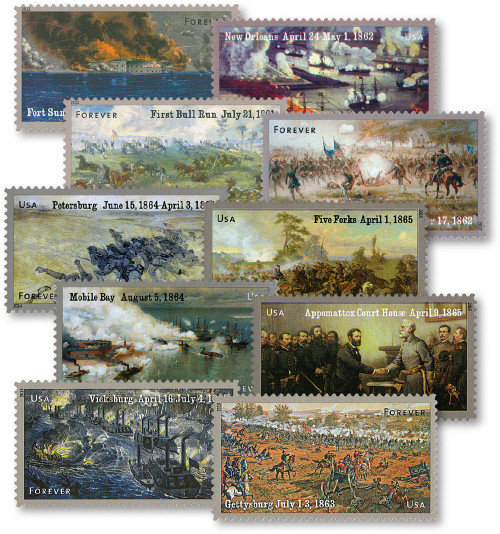
# 4787-88 - 2013 First-Class Forever Stamp - The Civil War Sesquicentennial, 1863
U.S. # 4787-88
2013 46¢ Civil War: 1863
Civil War Sesquicentennial
Although the Civil War would continue for nearly two years, the Confederacy suffered two stunning blows in as many days in 1863.
In the first battle, the South struck deep into enemy territory before suffering devastating losses at Gettysburg, Pennsylvania. During the three-day battle, Robert E. Lee’s full strength was concentrated against the Army of the Potomac. Although they breached the Union line on July 3, Confederate troops were unable to withstand withering artillery during “Pickett’s Charge.” Nearly one third of Lee’s army was casualties. During their retreat, their train of wounded Confederate soldiers stretched for more than fourteen miles.
In the West, Grant’s army had laid siege to Vicksburg, a key town along the Mississippi River. His men tried to battle their way into the fortified town in early spring, but the obstacles were insurmountable. Grant then tried to tunnel his army in, but that failed as well. The Union general then had his troops surround the town, cutting off its supply line, and begin a daily artillery assault. On July 4, after a 47-day siege, Confederate General John C. Pemberton surrendered. With its victory, the Union took control of the Mississippi River and severed the Confederacy in half.
Designed by art director Phil Jordan, the 2013 Civil War stamps feature the same format as previous issues, including traditional artwork. The Gettysburg stamp pictures an 1887 chromolithograph by Thure de Thustrup while the Vicksburg image was taken from an 1863 Currier and Ives lithograph. The selvage on the front of the pane pictures a Matthew Brady photo of Confederate prisoners at Gettysburg. There are also quotes from battlefield nurse Clara Barton, President Abraham Lincoln, Rufus Dawes, and William Tunnard (solders from each of the honored battles). The back of the pane tells the story of the two battles.
Value: 46¢ 1-ounce first-class letter rate
Issued: May 23, 2013
First Day City: Gettysburg, PA and Vicksburg, MS
Type of Stamp: Commemorative
Method: Photogravure printing in sheets of 72 in 6 panes of 12 (60 on one side, 12 on the other)
Perforation: Die Cut 11
Self-Adhesive
Quantity Printed: 10,800,000 stamps
These stamps were the third set in the five-year series commemorating the Civil War’s major battles. Each year, two significant battles from 150 years prior were honored with sheets similar to this one.
U.S. # 4787-88
2013 46¢ Civil War: 1863
Civil War Sesquicentennial
Although the Civil War would continue for nearly two years, the Confederacy suffered two stunning blows in as many days in 1863.
In the first battle, the South struck deep into enemy territory before suffering devastating losses at Gettysburg, Pennsylvania. During the three-day battle, Robert E. Lee’s full strength was concentrated against the Army of the Potomac. Although they breached the Union line on July 3, Confederate troops were unable to withstand withering artillery during “Pickett’s Charge.” Nearly one third of Lee’s army was casualties. During their retreat, their train of wounded Confederate soldiers stretched for more than fourteen miles.
In the West, Grant’s army had laid siege to Vicksburg, a key town along the Mississippi River. His men tried to battle their way into the fortified town in early spring, but the obstacles were insurmountable. Grant then tried to tunnel his army in, but that failed as well. The Union general then had his troops surround the town, cutting off its supply line, and begin a daily artillery assault. On July 4, after a 47-day siege, Confederate General John C. Pemberton surrendered. With its victory, the Union took control of the Mississippi River and severed the Confederacy in half.
Designed by art director Phil Jordan, the 2013 Civil War stamps feature the same format as previous issues, including traditional artwork. The Gettysburg stamp pictures an 1887 chromolithograph by Thure de Thustrup while the Vicksburg image was taken from an 1863 Currier and Ives lithograph. The selvage on the front of the pane pictures a Matthew Brady photo of Confederate prisoners at Gettysburg. There are also quotes from battlefield nurse Clara Barton, President Abraham Lincoln, Rufus Dawes, and William Tunnard (solders from each of the honored battles). The back of the pane tells the story of the two battles.
Value: 46¢ 1-ounce first-class letter rate
Issued: May 23, 2013
First Day City: Gettysburg, PA and Vicksburg, MS
Type of Stamp: Commemorative
Method: Photogravure printing in sheets of 72 in 6 panes of 12 (60 on one side, 12 on the other)
Perforation: Die Cut 11
Self-Adhesive
Quantity Printed: 10,800,000 stamps
These stamps were the third set in the five-year series commemorating the Civil War’s major battles. Each year, two significant battles from 150 years prior were honored with sheets similar to this one.












